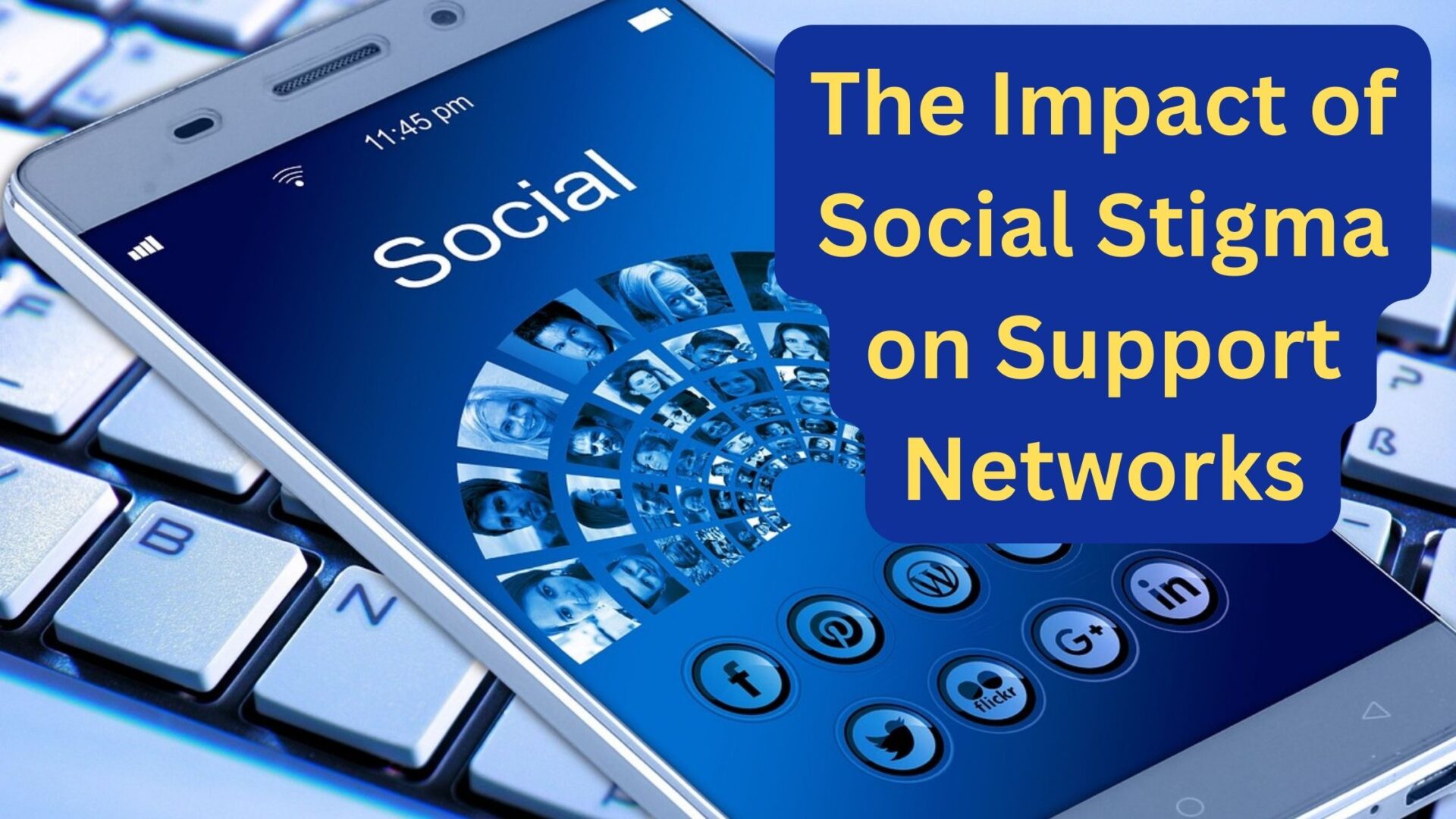Introduction:-
The Impact of Social Stigma on Support Networks

In a world where individuals often face trials and tribulations, the support of friends, family, and community can be a lifeline. However, the willingness to help those facing difficulties isn’t solely determined by goodwill. Social stigma, the negative perception and judgment attached to certain situations or individuals, can cast a long shadow on the support networks we rely on. This article delves into the profound impact of social stigma on people’s willingness to provide assistance and explores the far-reaching consequences of societal judgment.
Discusses how social stigma can affect people’s willingness to help those facing difficulties.
The Barrier of Social Stigma
Social stigma creates a barrier between those seeking help and those who could potentially offer it. When individuals grapple with issues that are stigmatized by society, such as mental health challenges, addiction, or financial hardship, they often encounter reluctance from others to get involved. This reluctance stems from several factors:
1. Fear of Association: People may fear that assisting someone facing stigmatized issues will lead to association with those issues, potentially damaging their own reputation. This fear can discourage them from offering help.
2. Lack of Understanding: Misconceptions and limited knowledge about stigmatized problems can foster discomfort and unease. People may hesitate to provide support due to a lack of understanding.
3. Fear of Discomfort: Interacting with someone facing a stigmatized issue can be emotionally challenging. Conversations may touch on sensitive topics, and individuals may fear saying or doing the wrong thing.
Explores the consequences of societal judgment.
The Consequences of Societal Judgment
The consequences of societal judgment extend far beyond the immediate reluctance to help. They can have profound and lasting effects on both individuals and communities:
1. Isolation and Shame: People facing stigmatized issues often feel isolated and ashamed, as society’s judgment can lead them to internalize negative beliefs about themselves. This isolation can worsen their condition and hinder their ability to seek help.
2. Reduced Access to Support: Stigmatized issues are less likely to receive attention, funding, and resources. Consequently, individuals and communities dealing with these problems may have limited access to support services, making it even more challenging to overcome difficulties.
3. Delayed Treatment: Stigma can deter individuals from seeking timely treatment or assistance. They may wait until their situation becomes dire, exacerbating the problem and making recovery more difficult.
4. Perpetuating Stereotypes: Societal judgment perpetuates stereotypes and misconceptions, making it difficult to combat stigmatized issues effectively. These stereotypes can lead to discrimination and unequal treatment.
Combatting Social Stigma
It’s crucial to recognize the destructive influence of social stigma and work toward its reduction. Here are some ways to combat social stigma and promote a more compassionate society:
1. Education and Awareness: Promote education and awareness about stigmatized issues to dispel myths and misconceptions. Knowledge is a powerful tool in reducing stigma.
2. Open Conversations: Encourage open and empathetic conversations about stigmatized topics. Foster an environment where individuals feel safe discussing their challenges without fear of judgment.
3. Advocacy: Support organizations and advocacy groups that work to reduce stigma and provide resources to those in need.
4. Empathy and Compassion: Practice empathy and compassion towards individuals facing difficulties. By understanding their struggles and offering a helping hand, we can create a more supportive society.
Provides tips for effective communication and understanding.
Effective communication and understanding are essential for building strong relationships, resolving conflicts, and fostering empathy. Here are some tips to improve your communication and enhance your ability to understand others:

- Active Listening: Pay full attention to the speaker, and avoid interrupting or formulating your response while they are talking. Show that you are listening through verbal cues like “I see,” “I understand,” or non-verbal cues like nodding.
- Empathetic Listening: Try to understand the speaker’s perspective and emotions. Put yourself in their shoes and imagine how they might be feeling. This can help you respond with empathy and compassion.
- Ask Open-Ended Questions: Encourage deeper conversations by asking open-ended questions that cannot be answered with a simple “yes” or “no.” For example, instead of asking, “Did you have a good day?” ask, “What made your day enjoyable?”
- Avoid Assumptions: Don’t assume you know what someone is thinking or feeling. Clarify by asking questions and seeking clarification when necessary. Assumptions can lead to misunderstandings.
- Paraphrasing: Repeat back what you’ve heard in your own words to ensure you’ve understood correctly. This not only confirms your understanding but also shows the speaker that you’re engaged in the conversation.
- Maintain Eye Contact: When appropriate, maintain eye contact to show that you are focused on the conversation. This can convey sincerity and interest.
- Use Mirroring: Match the speaker’s body language and tone to create a sense of rapport and connection. However, do this subtly to avoid coming across as insincere.
- Stay Calm: Maintain emotional composure, even in difficult conversations. When emotions run high, take a break if needed, and return to the conversation when you’re both calmer.
- Avoid Judgment: Suspend judgment and refrain from criticizing or blaming. Create a safe space for open dialogue where people feel comfortable sharing their thoughts and feelings.
- Be Patient: Some individuals may take longer to express themselves or may struggle with articulating their thoughts. Be patient and allow them the time they need to communicate effectively.
- Use “I” Statements: Express your thoughts and feelings using “I” statements rather than “you” statements. For example, say, “I felt hurt when…” instead of “You hurt me when…”
- Non-Verbal Communication: Be aware of your own non-verbal cues, such as body language and facial expressions. These can convey messages as powerful as words.
- Avoid Distractions: Minimize distractions when engaged in important conversations. Put away your phone, turn off the TV, and create a quiet environment for discussion.
- Seek Feedback: After a conversation, ask the other person for feedback on your communication. This shows your commitment to improvement.
- Practice Empathy: Develop your ability to empathize with others by actively trying to understand their emotions and experiences. Imagine how you would feel in their situation.
- Cultural Sensitivity: Be mindful of cultural differences in communication styles. What may be considered appropriate in one culture may not be in another.
- Reflect on Your Communication: Periodically reflect on your own communication skills and consider areas where you can improve. Personal growth is an ongoing process.
Effective communication and understanding take practice and patience. By implementing these tips, you can enhance your communication skills and build more meaningful and productive relationships with others.
Conclusion
Social stigma can create a significant hurdle for those in need, affecting their access to support and the willingness of others to provide it. Recognizing the impact of stigma and actively working to combat it is essential for fostering a more compassionate and inclusive society. By breaking down the barriers of stigma, we can create a world where individuals facing difficulties receive the support and understanding they deserve.
FAQs:
1. What is social stigma, and how does it affect support networks? Social stigma refers to negative attitudes, beliefs, and stereotypes held by society towards certain groups or individuals. When individuals are stigmatized due to factors such as race, gender, sexual orientation, mental illness, or disability, it can significantly impact their support networks. Stigma may lead to social isolation, rejection, and discrimination, making it difficult for individuals to access the support they need.
2. How does social stigma affect mental health support networks? Social stigma surrounding mental illness can prevent individuals from seeking help or disclosing their struggles to friends, family, or healthcare professionals. Fear of judgment or rejection may lead individuals to withdraw from their support networks, exacerbating feelings of loneliness and isolation. As a result, those affected by mental health conditions may struggle to receive adequate support and treatment.
3. What are some common consequences of social stigma on support networks? Social stigma can weaken existing support networks and hinder the development of new ones. Individuals may experience a loss of trust in others, leading to feelings of alienation and disconnection. Stigma can also perpetuate feelings of shame and self-blame, further isolating individuals from sources of support and understanding.
4. How can social stigma be addressed to strengthen support networks? Addressing social stigma requires a multi-faceted approach involving education, advocacy, and policy change. Efforts to challenge stereotypes, promote empathy, and foster inclusive communities can help reduce the impact of stigma on support networks. Creating safe spaces for open dialogue and providing access to culturally sensitive support services are also essential steps in overcoming stigma and building stronger support networks.
5. What role do support networks play in combating social stigma? Support networks serve as crucial sources of validation, acceptance, and empowerment for individuals affected by social stigma. By providing unconditional support and understanding, friends, family, and community members can counteract the negative effects of stigma and promote resilience. Additionally, peer support groups and advocacy organizations play a vital role in raising awareness, challenging stigma, and advocating for systemic change.
References:
- Corrigan, P. W., & Watson, A. C. (2002). Understanding the impact of stigma on people with mental illness. World Psychiatry, 1(1), 16–20.
- Link, B. G., & Phelan, J. C. (2006). Stigma and its public health implications. The Lancet, 367(9509), 528–529.
- Major, B., & O’Brien, L. T. (2005). The social psychology of stigma. Annual Review of Psychology, 56, 393–421.
- Pescosolido, B. A., Martin, J. K., Lang, A., & Olafsdottir, S. (2008). Rethinking theoretical approaches to stigma: A Framework Integrating Normative Influences on Stigma (FINIS). Social Science & Medicine, 67(3), 431–440.
- Thornicroft, G. (2006). Shunned: Discrimination against people with mental illness. Oxford University Press.







